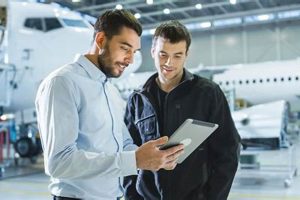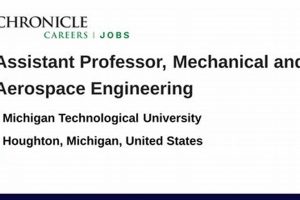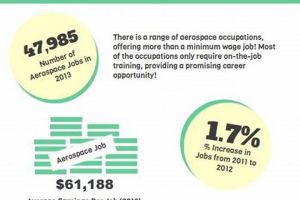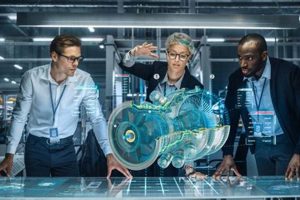The core function involves designing, developing, testing, and supervising the manufacturing of aircraft and spacecraft. This encompasses a wide range of activities, from conceptualizing initial designs to overseeing the final production stages. For example, an engineer might be responsible for creating aerodynamic models for a new airplane wing or developing the propulsion system for a satellite.
This profession is vital to advancements in air travel, space exploration, and national defense. Its contributions include increased fuel efficiency in commercial airlines, the creation of communication satellites that connect the globe, and the development of advanced defense systems that protect national security. Historically, these professionals have driven innovations that have reshaped society, from the first powered flight to the lunar landing.
The diverse aspects of this engineering discipline include specialization in areas such as aerodynamics, propulsion, structures, and control systems. Subsequent sections will elaborate on these specializations and detail the specific responsibilities and tasks involved in each.
Essential Guidance for Aspiring Aerospace Engineers
The following recommendations offer insight for those pursuing a career in aerospace engineering, addressing critical aspects for professional development and success in this demanding field.
Tip 1: Solidify Foundational Knowledge: A robust understanding of mathematics, physics, and computer science is paramount. Mastery of calculus, differential equations, and linear algebra provides the necessary framework for advanced engineering concepts.
Tip 2: Gain Practical Experience: Seek internship opportunities with aerospace companies or research institutions. Hands-on experience provides valuable exposure to real-world engineering challenges and allows for the application of theoretical knowledge.
Tip 3: Develop Specialized Skills: Focus on developing expertise in a specific area, such as aerodynamics, propulsion, or structural analysis. Specialization enhances marketability and allows for deeper contributions to specific projects.
Tip 4: Master Relevant Software: Proficiency in software such as MATLAB, ANSYS, or CAD tools is essential for design, simulation, and analysis tasks. Continuous learning and adaptation to new software technologies are crucial.
Tip 5: Cultivate Strong Communication Skills: The ability to clearly communicate technical information, both verbally and in writing, is vital for collaboration and project success. Effective communication ensures that complex ideas are conveyed accurately and efficiently.
Tip 6: Stay Abreast of Industry Trends: The aerospace industry is constantly evolving. Regularly read industry publications, attend conferences, and engage with professional organizations to stay informed about emerging technologies and industry best practices.
Tip 7: Consider Advanced Education: A master’s degree or doctorate can open doors to more advanced research and development roles. Advanced studies provide opportunities to deepen knowledge and contribute to innovative projects.
These guidelines emphasize the importance of a strong academic foundation, practical experience, specialized skills, and continuous learning. Adhering to these principles will enhance an individual’s prospects for a successful and fulfilling career in aerospace engineering.
The subsequent sections will explore the long-term career prospects and potential paths for professional advancement in this dynamic field.
1. Design
Design is a central and indispensable aspect of an aerospace engineer’s responsibilities. It constitutes the initial phase of translating abstract concepts and performance requirements into tangible, functional systems and components.
- Conceptual Design
Conceptual design involves formulating the overall architecture of an aircraft or spacecraft. This includes defining its basic shape, dimensions, and performance characteristics. For example, when designing a new commercial aircraft, engineers must consider factors such as passenger capacity, range, speed, and fuel efficiency. The conceptual design phase culminates in preliminary sketches, simulations, and trade studies that evaluate different design options.
- Detailed Design
Detailed design refines the conceptual design by specifying the precise dimensions, materials, and manufacturing processes for each component. This stage requires meticulous attention to detail and a deep understanding of engineering principles. A real-world example includes designing the internal structure of an aircraft wing, ensuring it can withstand aerodynamic loads while minimizing weight. Detailed design also involves creating detailed engineering drawings and specifications that guide manufacturing.
- Simulation and Analysis
Throughout the design process, extensive simulation and analysis are conducted to validate the performance and safety of the design. Computational Fluid Dynamics (CFD) simulations are used to analyze airflow around aircraft, while Finite Element Analysis (FEA) is used to assess structural integrity. These analyses identify potential weaknesses or areas for improvement, ensuring the final design meets stringent performance and safety requirements.
- Systems Integration
Aerospace systems are highly complex, comprising numerous interconnected components. Design also encompasses the integration of these systems, ensuring they function seamlessly together. For instance, the design of an aircraft’s flight control system must be integrated with the aerodynamic design of the wings and tail. Effective systems integration is crucial for achieving optimal performance and reliability.
These facets of design collectively highlight the critical role it plays in the work of aerospace engineers. From initial concept to final implementation, design is an iterative process driven by engineering principles, analysis, and a commitment to safety and performance. This stage is a linchpin in contributing to innovation within the aerospace sector.
2. Development
Within the scope of an aerospace engineer’s duties, development serves as the pivotal stage where theoretical designs are transformed into tangible prototypes and functional systems. This phase bridges the gap between concept and reality, necessitating a combination of engineering expertise and practical implementation.
- Prototyping and Fabrication
Prototyping involves constructing preliminary models or functional prototypes of aerospace components and systems. This can range from fabricating scale models of aircraft for wind tunnel testing to creating full-scale prototypes of engine components. Real-world examples include 3D printing of turbine blades or the construction of composite fuselage sections. Successful prototyping validates design concepts and identifies potential manufacturing challenges early in the process.
- Software and System Integration
Modern aerospace systems rely heavily on sophisticated software and electronics. Development includes writing, testing, and integrating software for flight control systems, navigation systems, and communication systems. Integrating these software components with hardware requires meticulous attention to detail and a thorough understanding of system architecture. For instance, developing the software that controls an aircraft’s autopilot requires extensive testing and validation to ensure safe and reliable operation.
- Testing and Validation
Throughout the development phase, rigorous testing is conducted to ensure that components and systems meet performance and safety requirements. This includes both laboratory testing and field testing under realistic conditions. Examples include subjecting aircraft components to extreme temperatures and pressures in environmental test chambers, or conducting flight tests to evaluate aircraft performance. Testing provides crucial feedback for design refinement and ensures that the final product meets stringent aerospace standards.
- Process Optimization
Development also entails optimizing manufacturing processes to ensure efficient and cost-effective production. This can involve developing new manufacturing techniques, streamlining assembly processes, or implementing quality control measures. For example, aerospace engineers might work to optimize the process of bonding composite materials to reduce manufacturing time and improve structural integrity. Process optimization is essential for achieving economies of scale and maintaining competitiveness in the aerospace industry.
These facets of development underscore its importance in transforming conceptual designs into functional aerospace products. The process demands creativity, technical proficiency, and a commitment to continuous improvement. The ability to effectively manage the development phase is a critical element of an aerospace engineer’s contribution to innovation and progress in the field.
3. Testing
Testing constitutes a critical and integral phase in aerospace engineering, ensuring that designs and prototypes meet stringent performance, safety, and reliability standards. The rigor of testing directly correlates to the success and longevity of aerospace products, making it an indispensable function for engineers in this field.
- Wind Tunnel Testing
Wind tunnel testing assesses the aerodynamic characteristics of aircraft and spacecraft designs. Scale models are subjected to controlled airflow to simulate flight conditions, allowing engineers to measure lift, drag, and stability. Data obtained from wind tunnel tests informs design modifications and validates theoretical models. For example, wind tunnel testing is crucial in the design of aircraft wings to optimize lift and minimize drag, directly influencing fuel efficiency and overall performance. This directly relates to aerospace engineer by determining if the design is safe or efficient.
- Materials Testing
Materials testing evaluates the strength, durability, and resistance to environmental factors of materials used in aerospace construction. Specimens are subjected to various stresses, temperatures, and pressures to simulate operational conditions. Data from materials testing informs material selection and ensures that components can withstand the extreme conditions encountered in flight or space. For example, testing composite materials for resistance to fatigue is essential for ensuring the structural integrity of aircraft fuselages. It falls on the engineer to determine what materials are best to use and how to test them.
- Flight Testing
Flight testing involves evaluating the performance and handling characteristics of aircraft in real-world conditions. Instrumented aircraft are flown under various conditions, and data is collected on parameters such as speed, altitude, and maneuverability. Flight testing validates design assumptions and identifies any unforeseen issues or performance limitations. A specific instance is the flight testing of a new engine to assess its thrust, fuel consumption, and reliability. The testing would determine safety of the project for aerospace engineers.
- Non-Destructive Testing (NDT)
NDT techniques are used to inspect aerospace components for defects without causing damage. Methods such as ultrasonic testing, X-ray radiography, and dye penetrant inspection can detect cracks, voids, or other flaws that could compromise structural integrity. NDT is essential for ensuring the safety and reliability of critical components, such as turbine blades and landing gear. For instance, ultrasonic testing is routinely used to inspect aircraft wings for hidden cracks that could lead to catastrophic failure.
These facets underscore the critical role of testing in validating designs, ensuring safety, and optimizing performance in aerospace engineering. Through rigorous testing methodologies, engineers ensure that aircraft and spacecraft meet the demanding requirements of their operating environments, contributing to safer and more efficient air and space travel.
4. Manufacturing
Manufacturing represents a critical intersection with the work of aerospace engineers, as it is the stage where designs are physically realized. The engineer’s involvement extends beyond conceptualization; it encompasses the practical application of engineering principles to ensure efficient and precise production. For instance, the design of a composite aircraft wing necessitates close collaboration with manufacturing specialists to determine the optimal layup sequence, curing process, and inspection methods. Failure to integrate manufacturing considerations into the design phase can lead to costly rework, production delays, or compromised structural integrity.
The application of advanced manufacturing techniques, such as additive manufacturing (3D printing), exemplifies the interconnectedness of design and production. Aerospace engineers leverage additive manufacturing to create complex geometries and lightweight components that were previously unattainable through traditional methods. For example, intricate turbine blades with internal cooling channels can be produced using additive manufacturing, resulting in improved engine performance and fuel efficiency. The engineer’s role includes optimizing designs for additive manufacturing processes, selecting appropriate materials, and validating the structural integrity of printed components.
Effective manufacturing processes directly impact the cost, quality, and timeline of aerospace projects. The engineer must possess a thorough understanding of manufacturing constraints, material properties, and quality control measures to ensure that designs are producible and meet rigorous industry standards. Challenges such as maintaining tight tolerances, minimizing material waste, and ensuring consistent part quality require a collaborative approach involving design engineers, manufacturing specialists, and quality assurance personnel. Ultimately, successful manufacturing relies on a seamless integration of design and production expertise to deliver high-performance aerospace products.
5. Research
Research forms an indispensable pillar of aerospace engineering, underpinning advancements in technology and driving the evolution of aircraft and spacecraft design. It is through dedicated research initiatives that fundamental scientific principles are translated into practical applications, continually pushing the boundaries of what is achievable in the field.
- Aerodynamics Research
Aerodynamics research focuses on understanding and manipulating the behavior of air and other gases around moving objects. This involves computational fluid dynamics simulations, wind tunnel experiments, and flight tests to optimize aircraft wing designs, reduce drag, and enhance lift. The resulting data informs the development of more fuel-efficient and higher-performing aircraft. For instance, research into laminar flow control has led to the development of wing designs that significantly reduce friction drag, enhancing aircraft range and fuel economy. Aerospace engineers leverage these research findings to design more efficient and capable aircraft.
- Propulsion Systems Research
Propulsion systems research aims to improve the efficiency, power, and reliability of aircraft and spacecraft engines. This encompasses studies of combustion processes, turbine design, and advanced materials for engine components. Research into alternative fuels, such as biofuels and hydrogen, seeks to reduce the environmental impact of air travel. Recent research has focused on developing hybrid-electric propulsion systems for aircraft, combining the benefits of electric motors with traditional combustion engines. Aerospace engineers apply these innovations to create more sustainable and efficient propulsion systems.
- Materials Science Research
Materials science research focuses on developing new materials with enhanced strength, weight, and temperature resistance properties for aerospace applications. This includes research into composite materials, alloys, and ceramics that can withstand the extreme conditions encountered in flight and space. Nanomaterials research holds promise for creating lightweight and ultra-strong components. For example, carbon nanotube-reinforced composites are being investigated for use in aircraft fuselages and wings, offering significant weight savings and improved structural performance. Aerospace engineers integrate these advanced materials into aircraft and spacecraft designs.
- Space Exploration Research
Space exploration research aims to develop the technologies and systems needed for exploring and utilizing space. This encompasses research into propulsion systems for spacecraft, robotics for planetary exploration, and life support systems for astronauts. Research into radiation shielding and closed-loop life support systems is crucial for enabling long-duration space missions. Advancements in autonomous navigation and control systems are enabling robotic spacecraft to explore distant planets and moons. Aerospace engineers are at the forefront of these research efforts, designing the next generation of spacecraft and exploration technologies.
These facets collectively highlight the pivotal role of research in driving progress in aerospace engineering. By continually pushing the boundaries of knowledge and technology, research enables the development of safer, more efficient, and more capable aircraft and spacecraft, contributing to the advancement of both air travel and space exploration.
6. Analysis
Analysis constitutes an indispensable function within aerospace engineering, serving as the foundation for informed decision-making throughout the lifecycle of aircraft and spacecraft. This encompasses the application of mathematical, computational, and experimental techniques to assess performance, safety, and reliability. Without rigorous analysis, designs remain theoretical, and potential flaws may go undetected, leading to catastrophic consequences. A primary example involves stress analysis of aircraft wings, where engineers employ finite element methods to predict stress distributions under various loading conditions. These analyses determine whether the wing structure can withstand operational forces without exceeding safety limits, directly influencing design choices and material selection. This level of scrutiny exemplifies the cause-and-effect relationship inherent in aerospace engineering, where analytical insights dictate design modifications.
Further, analysis extends beyond structural integrity to encompass aerodynamic performance, propulsion efficiency, and control system stability. Computational Fluid Dynamics (CFD) simulations are routinely used to analyze airflow patterns around aircraft, identifying areas of high drag or potential stall. Similarly, performance analysis of rocket engines evaluates thrust, specific impulse, and combustion efficiency, guiding engine design and optimization. A notable instance of the practical application of analysis is in the development of flight control systems. Stability analysis, employing techniques such as root locus and Bode plots, ensures that the aircraft remains controllable under varying flight conditions, preventing oscillations or loss of control. These analytical processes prevent failure and improve the design.
In summary, analysis is inextricably linked to aerospace engineering. It acts as the cornerstone for verifying designs, optimizing performance, and ensuring safety. Challenges remain in developing more accurate and efficient analytical tools, particularly for complex systems and novel materials. However, the commitment to rigorous analysis remains paramount in advancing the field and mitigating risks associated with air and space travel. By providing quantitative insights into system behavior, analysis empowers engineers to make informed decisions, ultimately leading to safer and more capable aerospace vehicles.
7. Management
Management functions as a critical, often unseen, component within aerospace engineering projects. Its effectiveness directly influences project success, resource allocation, and adherence to timelines. The ability to manage technical teams, budgets, and complex project requirements is an essential, though perhaps not immediately obvious, aspect of the profession.
- Project Planning and Scheduling
Effective project planning and scheduling are vital for aerospace endeavors, given their inherent complexity and extended timelines. This involves defining project scope, establishing milestones, allocating resources, and managing dependencies. For example, developing a new satellite requires meticulous planning, coordinating engineers working on different subsystems (communication, power, propulsion), and integrating their efforts into a cohesive whole. Failure to adequately plan and schedule can result in delays, cost overruns, and compromised performance. The engineer will create the plan for the project.
- Risk Management
Risk management involves identifying, assessing, and mitigating potential risks throughout the project lifecycle. Aerospace projects are inherently risky due to technological uncertainty, demanding performance requirements, and stringent safety standards. For example, developing a new aircraft engine involves risks related to materials failure, component integration, and system reliability. Effective risk management requires proactive identification of potential problems, development of contingency plans, and continuous monitoring of risk factors. The engineer must consider risk assessment on the project.
- Team Leadership and Coordination
Aerospace projects typically involve multidisciplinary teams of engineers, scientists, and technicians. Effective team leadership and coordination are essential for fostering collaboration, resolving conflicts, and ensuring that team members work effectively towards common goals. A project involving the design and construction of a new spacecraft requires coordination between engineers specializing in propulsion, guidance and control, thermal management, and communications. Strong leadership ensures that team members communicate effectively, share knowledge, and resolve technical challenges collaboratively. An engineer takes lead of the coordination team.
- Budget Management and Cost Control
Aerospace projects are often characterized by significant financial investments and stringent budget constraints. Effective budget management and cost control are essential for ensuring that projects are completed within allocated funding. This involves developing detailed cost estimates, monitoring expenditures, and implementing cost-saving measures where appropriate. For example, developing a new launch vehicle requires careful management of costs associated with materials, manufacturing, testing, and labor. The engineer is in charge of the budget that the project requires.
These facets underscore how management is woven into the fabric of aerospace engineering. From coordinating diverse teams to mitigating potential risks and managing complex budgets, management skills are essential for ensuring project success and driving innovation within this demanding field. While technical expertise is undoubtedly crucial, it is the ability to effectively manage projects and people that often distinguishes successful aerospace engineers.
Frequently Asked Questions
The following section addresses common queries and misconceptions regarding the multifaceted responsibilities and demands of this challenging engineering discipline.
Question 1: Is an aerospace engineer’s work limited to designing airplanes and rockets?
The responsibilities extend beyond these two areas. The profession also encompasses the design and development of satellites, missiles, and other airborne and spaceborne vehicles. Moreover, related technologies, such as navigation and control systems, also fall within the purview of the work.
Question 2: What are the typical educational requirements to pursue the job of an aerospace engineer?
A bachelor’s degree in aerospace engineering or a closely related field is generally considered the minimum requirement for entry-level positions. Advanced roles and research positions often necessitate a master’s degree or doctorate.
Question 3: How important are computer skills in performing the job of an aerospace engineer?
Computer skills are crucial. The job relies heavily on computer-aided design (CAD) software, computational fluid dynamics (CFD) tools, and other simulation and analysis programs. Proficiency in programming languages is also highly valuable.
Question 4: What role does testing play in the job?
Testing is an integral aspect. Engineers conduct a variety of tests, ranging from wind tunnel experiments to flight tests, to validate designs and ensure that systems meet stringent performance and safety requirements.
Question 5: Is creativity a necessary skill for the profession?
Creativity is vital for generating innovative solutions to complex engineering challenges. The profession demands creative thinking in areas such as designing new aircraft configurations, developing advanced propulsion systems, and optimizing spacecraft trajectories.
Question 6: Does the job typically involve significant teamwork?
Teamwork is essential. Engineers frequently work in multidisciplinary teams, collaborating with other engineers, scientists, and technicians to achieve project goals. Effective communication and collaboration skills are therefore highly important.
In summary, the questions highlight the multifaceted nature of the profession, underscoring the importance of a strong educational foundation, technical proficiency, and collaborative skills.
The next section will summarize key takeaways regarding the work of an aerospace engineer and offer guidance for further exploration.
What is the Job of an Aerospace Engineer
This exploration has elucidated the diverse and demanding nature of “what is the job of an aerospace engineer.” The profession encompasses design, development, testing, manufacturing, research, analysis, and management. These interconnected functions contribute to the creation, improvement, and safe operation of air and space vehicles. The necessity for a robust understanding of engineering principles, coupled with proficiency in relevant software and effective teamwork skills, has been emphasized. These skills will help the aerospace engineers to work in the field.
Advancements in air and space travel are intrinsically linked to the contributions of this engineering discipline. Continuous pursuit of knowledge and the development of innovative solutions are essential for addressing future challenges and expanding the boundaries of aerospace technology. Further inquiry into specialized areas and emerging trends within the field is encouraged for those seeking a deeper understanding of its potential impact on society and the world.







